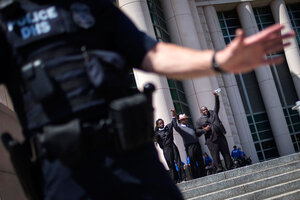New audio in Michael Brown case: How important in whirl of narratives?
A new audio recording could be of the Michael Brown shooting. But it does very little to clarify what happened in Ferguson and could just fuel competing narratives.

Activists raise their hands in solidarity as a policeman tries to block others, who were demanding justice for the shooting death of teen Michael Brown, from advancing onto the steps to the Thomas F. Eagleton United States Courthouse in downtown St. Louis Tuesday.
Adrees Latif/Reuters
A new audio tape that purportedly contains the sounds of shots fired by Ferguson, Mo., police officer Darren Wilson at Michael Brown is raising new questions about the actual dynamics of a killing that sparked social unrest and a national debate over police tactics.
The audio recording indicates two distinct volleys of shots. Ten or 11 shots can be heard with a pause between the sixth shot and shots that followed.
Was the pause the moment Mr. Brown raised his hands in surrender and was killed nevertheless? Or did Brown attack Wilson, forcing the officer to fire again in self-defense?
Reactions to the new piece of evidence highlight the powerful dynamics of culture and law at play. In the absence of facts in such a high-profile case, rumors and competing narratives take hold.
Officer Wilson's supporters circulated anonymous and unconfirmed reports that his orbital bone had been broken. Protesters calling for Wilson's arrest say the shooting fits a familiar saga of black, unarmed kids making a mistake, giving lip to authority, resisting, and paying with their lives. Pro-Wilson and pro-Brown activists recently hurled epithets at each other across a public street in Ferguson.
Investigators' challenge is to glue eyewitness testimony to known facts and deliver a logical conclusion to how and why Wilson killed Brown. But the swirl of accusation and rumor around the case affects legal proceedings, experts say.
“Unfortunately, you can’t separate the narratives from the investigation – whether they describe the basic logic of the situation or offer more an alibi [for Wilson] than a narrative,” says George Ciccariello-Maher, a political theorist at Drexel University, in Philadelphia. “The investigation is shaped by these narratives, and you can’t get a jury that’s immune to them.”
What is not disputed is that Wilson killed Brown shortly after noon on Aug. 9. What happened in the moments before is still far from clear, and the audio recording, while compelling, in many ways only adds to the sense of confusion at this point.
For their part, Ferguson police say Brown was a suspect in a shoplifting incident at a liquor store shortly before his encounter with Wilson – but Wilson did not tie Brown to the robbery at first. He told Brown to get off Canfield Street and onto the sidewalk. At that point, police say, Wilson saw the box of cigars, connecting Brown to the theft.
There, the competing narratives begin to diverge. Brown could well have thought arrest was imminent as soon as Wilson pulled up, giving him motivation to resist, perhaps even attack the officer, says former Cobb County, Ga., police officer Lance LoRusso, author of “When Cops Kill.”
After the officer backed his cruiser up and tried to get out, Brown, whether intentionally or not, prevented him. Police say Brown went for Wilson’s gun and the gun went off. Wilson then pursued Brown for a short distance before the two faced each other again.
For Brown’s defenders, the pause in the recording plays to the theory that a young, white cop who allegedly got punched sees red and disregards Brown’s hands-up submission. In that scenario, the pause embodied a broader “calculus of worth and a calculus of consequences in which … young black men in general are not considered to be worth as much,” says Mr. Ciccariello-Maher.
That narrative has been fed by eyewitness accounts that Brown was shot while running away, but that doesn’t square with an autopsy that shows no bullet wounds to the back of the torso or legs, according to CBS News.
In the opposing scenario, a cop who has already fired his weapon once fires again as he again comes under attack from a larger man. According to that theory, Wilson is entirely justified because he can reasonably expect to be seriously hurt or even killed if he doesn’t shoot.
“If it’s an imminent threat of serious bodily harm, yeah, you become the judge, jury, and executioner,” Geoffrey Alpert, a University of South Carolina criminologist, told The Washington Post.
That narrative has fed rumors that Wilson had a broken orbital bone and injuries other than the “swollen face” police reported, but there has been no confirmation of those reports.
A grand jury now has to find “probable cause” that a crime occurred to indict Wilson. A prosecutor would then have to convince a jury beyond a reasonable doubt that Wilson acted with some degree of malice or negligence instead of in self-defense when he opened fire. A parallel federal investigation will determine whether Wilson violated Brown’s Fourth Amendment due process rights.
So far, Wilson hasn’t made any public comments. He is on administrative leave and under 24-hour protection.
According to the Post, Wilson is a young officer with a rough upbringing who had been fired along with all his colleagues after nearby Jennings, Mo., dismantled a corrupt and allegedly racist police department. Other than that, Wilson had only commendations on his record, and that remained true until the Aug. 9 shooting of Brown.
For Brown’s part, he was an aspiring rapper and future vocational-tech college student interested in air conditioning repair. He’s been described as a “gentle giant” who was too soft to play football, but also as a young man who occasionally fell in with the wrong crowd and made mischief. A purported Brown rap sheet has circulated on the Internet, but law enforcement in St. Louis County say Brown had no priors.

